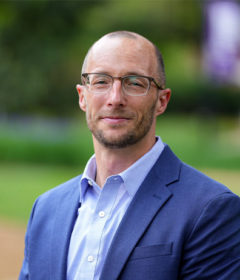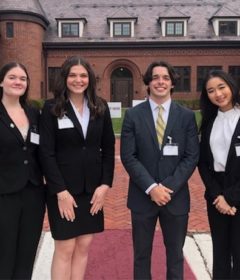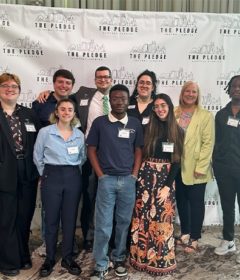Weathering the Storm


Student activism on campuses across the United States in recent months has reached a high-water mark not seen in half a century. According to a study by the Higher Education Research Institute (HERI) at the University of California, Los Angeles, one in three students demonstrated for some kind of cause in 2016.
Fifty years ago, much of students’ concern was epitomized by the famous flower-carrying Summer of Love. In recent days, it has been more of a winter of discontent. And, while much of the attention back in 1967 was on a war 8,000 miles away, now it is on issues closer to home — with diversity, inclusion and campus climate high on the agenda.
Not only has the focus of student activism changed, so, too, has the face.
Back in 1971, 90 percent of full-time, first-year college students were white. Blacks comprised 7 percent of full-time, first-year students, with Asians and Latinos accounting for 0.5 percent and 0.4 percent, respectively, reports HERI’s “The American Freshman: Fifty-Year Trends 1966–2015.”
The most recent statistics show a starkly different picture. Today, the breakdown is 58 percent white, 13 percent mixed race/ ethnicity, 10 percent each for Asian and Latino, and 8.5 percent black.
Notably, such a shift is somewhat in line with broader societal changes, with non-Hispanic whites comprising 63 percent of the U.S. population, followed by Hispanics at 17 percent; blacks at 12 percent; Asians at 5 percent; and multiracial Americans at more than 2 percent.
The shift has been beneficial. The greater campus diversity has been found to improve educational outcomes for all students, not only minority groups. The business world, meanwhile, is mostly looking for a more diverse workforce. Although some business regionalization does exist, globalization continues as a trend, transcending cultures and enabling new markets to emerge among minority communities, from those involving sexual orientation to those with disabilities.
Perhaps Better — But No Cause for Celebration
Yet, the “Fifty-Year Trends” study hints that any celebration over apparent diversity advances on campuses may be premature. Consider this: The study also reveals self-rated emotional health among students has declined over the latter three decades in which it has been tracked.
The student body may be more diverse these days, but it’s not particularly well.
That condition is borne out by the almost 60-percent dropout rate of higher-education students — many of whom fail to complete their studies not because they don’t have the ability, but because they are not helped to realize their best. The list of causes for dropout are “long and varied,” according to the 2011 Harvard Graduate School of Education study “Pathways to Prosperity: Meeting the challenge of preparing young Americans for the 21st century.”
The Association of American Colleges & Universities (AAC&U) in Washington, D.C., asserts that among the reasons is the “disconnect between diversity and educational excellence” — failing to make the kind of broad institutional and academic changes needed to ensure success. The AAC&U points to the failure to tackle the “persistent achievement gap” facing “historically underserved” African-American and Latino students, which means running the risk of failing a significant portion of today’s college-bound students “even as we diversify our campuses to a greater extent than ever before.”
A Sense of Belonging
Fact is, a lack of a sense of belonging is the No. 1 reason students leave higher education, says Sue Rankin, Ph.D., a Pennsylvania State University professor who has pioneered independent campus-climate assessments. Stetson is among the 170-plus institutions for which she and her team have conducted studies, with the results presented last summer as part of the university’s Many Voices, One Stetson initiative to improve inclusion.

Although academic success is important, it’s not the only reason to want students to feel more at home while at school. Two other chief concerns for institutions, binge drinking and sexual assault, also are linked to a sense of belonging. Example: Marginalized new students — often first-generation, lower-income, students of color or of alternative sexual orientation — may go to a party they usually wouldn’t attend simply to try to fit in, Rankin contends.
“Add a little alcohol to that,” Rankin says, “and it can cause situations you normally wouldn’t be in as you try to belong to that particular place.”
If some schools have looked at their changing student demographics and given themselves a pat on the back, that sense of self-satisfaction has been rocked over the past couple of years. Most recently, countless campus demonstrations about Black Lives Matter, transgender rights and the fears of undocumented students have surfaced, heightened further by a volatile election season.
As part of the general discontent with current times, as well as events on particular campuses, some student groups have issued lists of demands to colleges and universities, ranging from the dismissal of current leadership to the removal of references to past benefactors.
“The protests we have been seeing are an indication that universities are not really living up to their promise [of diversity and inclusion],” comments Donna Young, Ph.D., a professor at Albany Law School in New York and a member of the American Association of University Professors’ committee on Academic Freedom and Tenure.
The protests also have been something of a wake-up call, forcing the issue to the fore. Emblematic of that push was a special focus on diversity and inclusion issues at the AAC&U’s annual meeting in January 2017 (Building Public Trust in the Promise of Liberal Education and Inclusive Excellence), while a second AAC&U event in March is slated to look at the importance of diversity in student success.
The Path to Climate Change
Meanwhile, the Association of Governing Boards of Universities and Colleges (AGB) recently released a statement on “campus climate, inclusion and civility” to help leaders assess and improve their schools’ health.
Doing so appears both principled and practical. In addition to inherent morals and ethics, diversity and inclusion are “market issues,” says AGB senior fellow Artis Hampshire-Cowan, J.D., former senior vice president and secretary of the board at Howard University, a historically black college. “If your institution has a reputation for not being diverse and inclusive and civil, you are not going to attract students and you are not going to retain them,” Hampshire- Cowan comments.
Clearly, inclusion is important to millennials, which three years ago prompted BestColleges.com to also rank the nation’s top 100 universities by their diversity. In 2016, Stanford University topped the list, but even that distinction comes with a caveat: A mixed student body doesn’t necessarily mean a school is achieving all of its diversity goals.
Ensuring that students A to Z are included on campus requires wrestling with complex issues, such as balancing concern for individuals with a commitment to academic freedom — a crucial debate sometimes trivialized by mainstream media that cartoon the issue merely as coddled students whining about the need for “trigger warnings” and “safe spaces.”

While Hampshire-Cowan affirms that part of higher education’s role is to stretch students beyond their familiar comfort zone, she notes, “Uncomfortable is fine, but feeling afraid for your personal safety is another issue.”
Rebecca Dolinsky Graham, AAC&U’s director for student success in the Office of Diversity, Equity and Student Success, adds that although the ideal of diversity on campus may be broadly accepted, much needs to be done to make it more of a reality. “It’s not just about numbers,” says Graham. “They don’t resolve the fact that perhaps the campuses aren’t structurally set up to ensure that students succeed.”
Getting to where they do succeed means shifting from a focus on equality to equity, which Graham contrasts as sameness versus fairness. This emphasis is being championed by groups like the Center for Urban Education at the University of Southern California, which advocates changes that tackle “the historical marginalization of some racial and ethnic groups.”
By way of example, the Center for Urban Education points to how a redesign of the math department at a Colorado community college, including the addition of mentoring and a support lab, saw success rates for low-placing black students treble over a two-year period. Those students had long lagged behind white and Hispanic peers.
That’s a promising result.
Challenges Ahead
Change, however, doesn’t come easily. The American Council on Education, representing nearly 1,800 college and university presidents and the executives at related associations, blames the recent campus unrest on “a troubling and rising level of institutional complacency surrounding diversity issues.”
Also, progress is problematic even for the willing. HERI’s “2016 Diverse Learning Environment” study concluded that while “students may recognize their institutions’ efforts in promoting an appreciation for cultural differences … they continue to encounter and perceive racial tensions in their daily experiences.”
Those experiences could include what Rankin calls “micro-aggression.” Rankin told of a tall African-American student who upon arriving at his first engineering class was asked by the professor, “Do you play basketball?”
For Donald Harward, president emeritus of Bates College in Maine and co-founder/director of Bringing Theory to Practice (a partner of the AAC&U), progress in diversity is a battle against so-called tradition. When it comes to schools advocating for “sustainable campus cultures” that help students succeed, he believes some schools are “well along” while others fall behind. Among his reasons: “Diversity is a challenge to entrenched power and the status quo.”
Despite recent events, Harward is concerned that diversity remains a peripheral issue for many schools.
At the same time, Harward does offer optimism. Applauding Stetson’s climate study as an important first step on its campus, he comments, “My hope, my argument would be that as educators, as citizens, as persons who have great hope in the promise of not only the academy but democratic and civil society, that the issues of campus climate, including the role of diversity as core and central to it, is indeed an essential objective for higher education.”
Young of the AAC&U agrees, concluding, “Diversity is not a catchphrase or a fad. It goes really to the heart of our rights as human beings.”
-Andy Butcher
Note: This article originally appeared in the Winter 2017 issue of Stetson University Magazine. To read the entire magazine, click here. The next issue of the magazine is scheduled for publication in June.



